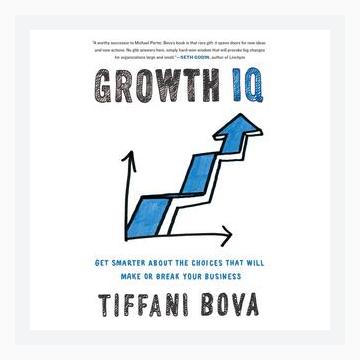Business StrategyStrategic Planning
Title: Growth IQ: Get Smarter About the Choices That Will Make or Break Your Business
Author: Tiffani Bova
Published: 2018
Category: Strategic Planning
Tiffani Bova’s “Growth IQ” is a strategic guide that explores the various ways businesses can unlock their potential and achieve sustained growth. The book is structured around ten distinct growth paths and emphasizes that no single approach guarantees success; rather, the combination and timing of strategies are crucial. Below is a detailed summary of the major points from the book, including actionable insights and concrete examples.
1. The Power of Customer Experience
Concept:
Bova highlights that enhancing the customer experience (CX) plays a crucial role in driving growth. Superior CX can lead to increased customer loyalty, higher retention rates, and positive word-of-mouth.
Example:
Bova examines companies like Amazon, where relentless focus on customer satisfaction has consistently driven growth. Amazon uses personalized recommendations and seamless purchase processes to create an exceptional CX.
Action:
Audit your customer experience journey by gathering feedback through surveys and direct interactions. Implement changes based on insights to streamline processes and exceed customer expectations.
2. Customer Base Penetration
Concept:
Increasing sales to existing customers by expanding their engagement with different products or services.
Example:
Bova discusses the case of Starbucks, which expanded its product line by introducing seasonal items and loyalty programs to encourage frequent purchases.
Action:
Analyze your current customers’ purchase patterns and explore opportunities to cross-sell or upsell related products or services. Develop loyalty programs to incentivize repeat business.
3. Market Acceleration
Concept:
Grow by entering new geographic markets or industry segments, effectively broadening your customer base.
Example:
Hyundai Motor Company’s expansion strategy involved moving into the U.S. market, offering affordable yet reliable cars that filled a market gap.
Action:
Conduct market research to identify potential new markets that align with your business strengths. Develop a tailored market entry strategy, considering local market demands and cultural nuances.
4. Product Expansion
Concept:
Introducing new products or enhancing existing ones to tap into existing and new customer segments.
Example:
Apple’s continuous innovation, such as evolving from the iPod to the iPhone, and then branching into services like iTunes and the App Store, illustrates this strategy well.
Action:
Leverage customer feedback and market trends to identify gaps in your product line. Invest in research and development to innovate and launch new products that meet emerging customer needs.
5. Customer and Product Diversification
Concept:
Diversifying both your product offerings and customer segments to spread risk and identify new revenue streams.
Example:
Bova mentions Disney’s diversification from movie production to theme parks, cruise lines, and media networks.
Action:
Evaluate your current portfolio and identify opportunities for diversification. Consider investing in adjacent markets or complementary products that can appeal to a new customer segment.
6. Partnerships and Alliances
Concept:
Forming strategic partnerships can enhance capabilities, reach new customers, and enter new markets.
Example:
Bova highlights Dropbox’s partnership with Microsoft to integrate its cloud storage service with Office 365, thereby expanding its customer base.
Action:
Identify potential partners who have complementary strengths. Develop mutually beneficial agreements that outline clear objectives, responsibilities, and outcomes.
7. Co-opetition
Concept:
Working cooperatively with competitors to achieve common goals, often leading to win-win situations.
Example:
Samsung and Apple, despite being rivals, have collaborated on various technology components necessary for each other’s devices.
Action:
Look for competitors with whom you can share market opportunities. Suggest collaborative projects that can benefit both parties, such as joint ventures or shared technology platforms.
8. Unconventional Strategies
Concept:
Adopting innovative and unconventional strategies to disrupt the market and gain competitive advantage.
Example:
Bova points to Tesla’s direct-to-consumer sales model, which bypasses traditional car dealership networks.
Action:
Encourage a culture of innovation within your organization. Challenge traditional industry norms and explore bold, unconventional approaches to distinguish your brand.
9. Operational Excellence
Concept:
Focusing on internal efficiency and process improvements to drive cost reductions and enhance productivity.
Example:
Toyota’s lean manufacturing methodologies and Kaizen continuous improvement practices are prime examples of operational excellence driving growth.
Action:
Implement regular reviews of your business processes to identify inefficiencies. Introduce lean management principles and foster a culture of continuous improvement.
10. Optimize the Sales Approach
Concept:
Enhancing sales techniques to better meet customer needs and maximize conversions.
Example:
Bova references Salesforce’s success in optimizing their sales approach by leveraging data analytics and personalized customer interactions.
Action:
Invest in sales training and tools that provide insights into customer behavior. Use data analytics to refine sales strategies and personalize the sales process for better engagement.
Conclusion and Action Plan
Bova asserts that the key to achieving growth lies in the ability to combine these paths effectively. Each company’s growth journey is unique, and recognizing the right time and context for each strategy is paramount.
Action Plan for Growth:
1. Evaluate Your Current Position: Understand where your business stands in terms of customer satisfaction, market reach, product portfolio, and operational efficiency.
2. Identify Growth Opportunities: Use the ten growth paths to pinpoint potential areas where your business can expand or optimize.
3. Develop a Strategic Plan: Craft a comprehensive strategy that includes a mix of growth paths tailored to your business needs.
4. Implement and Monitor: Put the plan into action, continually monitor progress, and be adaptive to change.
5. Foster a Culture of Adaptability and Innovation: Encourage your team to be flexible and innovative in responding to market shifts.
By assimilating the lessons and growth paths highlighted by Bova, businesses can navigate their growth journey more effectively and achieve sustainable success. This book serves as a tactical guide for business leaders seeking to enhance their strategic planning and drive growth through informed decision-making.
This structured summary encapsulates the core ideas of Tiffani Bova’s “Growth IQ,” providing actionable steps and concrete examples to help businesses leverage the book’s insights for their growth strategies.
